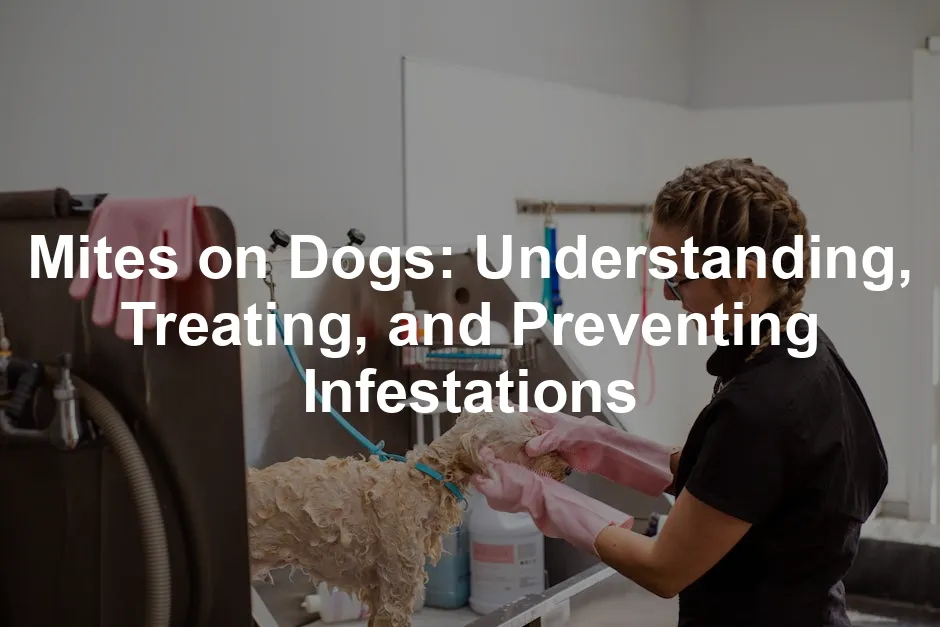Introduction
Recognizing mites on dogs is crucial for their health. These tiny pests can cause significant discomfort and health issues. Common symptoms like itching, redness, and hair loss can indicate an infestation. Timely intervention is important to ensure your dog remains healthy and happy.
To keep your pup feeling fresh and free from those pesky mites, consider using a Pet Medicated Shampoo for Dogs. This will not only help cleanse their coat but also soothe their skin, making bath time a delightful experience instead of a dreaded chore!

Summary and Overview
Dog mites are microscopic parasites that can affect your pet’s skin and overall health. They can lead to conditions like mange, causing irritation and inflammation. There are several types of mites that commonly infest dogs, including Sarcoptes, Demodex, Otodectes, and Cheyletiella. Understanding these mites is vital for effective treatment and prevention. By being aware of the signs of mite infestations, you can take proactive steps to protect your furry friend from potential harm. Early detection and treatment can prevent more serious health issues down the line.
And while you’re at it, don’t forget to stock up on a Dog Grooming Brush. Regular brushing not only keeps their coat looking fabulous but also helps you spot any unusual lumps or bumps that could be hiding under that fur!
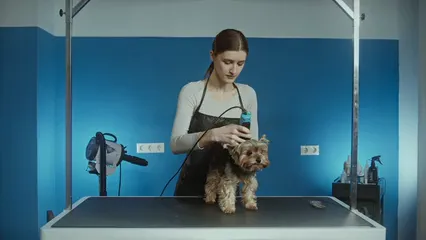
Types of Mites Affecting Dogs
Sarcoptes Mites (Sarcoptic Mange)
Sarcoptes mites, also known as scabies mites, are highly contagious parasites. They burrow into your dog’s skin, causing severe discomfort. The life cycle of these mites lasts about 17 to 21 days. Female mites lay eggs in the skin, leading to multiple generations quickly.
Symptoms include intense itching, redness, and crusty lesions. You might notice sores on the ears, elbows, and belly. These mites can spread easily from dog to dog. They can even affect humans, causing similar itching and irritation. This zoonotic potential makes it essential to address infestations promptly.
Demodex Mites (Demodectic Mange)
Demodex mites, often referred to as follicle mites, are normally present in small numbers on healthy dogs. They reside in hair follicles and sebaceous glands, playing a part in skin health. However, if a dog’s immune system is compromised, these mites can multiply excessively, causing demodectic mange.
If you’re dealing with Demodex, you might want to consider a Dog Skin and Coat Supplement. These supplements can help support your dog’s skin health from the inside out, giving them the extra boost they need to fight off those pesky mites!
Ear Mites (Otodectes cynotis)
Ear mites, scientifically known as Otodectes cynotis, are tiny parasites that primarily inhabit your dog’s ear canal. These pesky mites feed on ear debris, leading to inflammation and discomfort. Symptoms include intense itching, head shaking, and a dark, waxy discharge from the ears. You might also notice your dog scratching at its ears frequently.
For those ear mite troubles, a reliable Dog Ear Cleaner Solution can be a game-changer. Regular cleaning can help prevent ear mite infestations and keep your pup’s ears healthy!
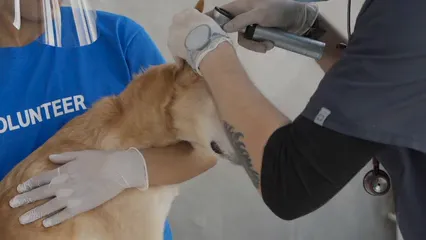
For a comprehensive understanding of ear mites in dogs and their management, visit ear mites in dogs.
Cheyletiella Mites (Walking Dandruff)
Cheyletiella mites, often referred to as “walking dandruff,” are another type of parasite that affects dogs. These mites live on the skin’s surface and are visible as tiny white flakes, resembling dandruff. Symptoms include itching, redness, and patches of flaky skin. In some cases, dogs may not show any signs at all.
Transmission between pets is common, especially in multi-pet households. These mites can easily spread through direct contact or shared bedding. Therefore, it’s essential to monitor all pets for signs of infestation. If left unchecked, Cheyletiella mites can lead to skin infections and increased discomfort for your furry friends.
Symptoms of Mite Infestations
Mite infestations can manifest through various symptoms, making it important for pet owners to stay vigilant. Common signs include:
- Intense itching and scratching
- Hair loss, either patchy or widespread
- Redness and irritation of the skin
- Flaky or scaly skin, often resembling dandruff
- Dark discharge from the ears, particularly with ear mites
- Sores or scabs due to excessive scratching
Different mites may cause specific symptoms. For instance, ear mites primarily affect the ears, while Sarcoptes mites lead to more generalized itching and irritation. If you observe any of these signs, consult your veterinarian for a thorough examination and diagnosis. Early intervention can prevent serious complications and help your dog feel better quickly.
To be fully prepared for any mishaps, a Dog First Aid Kit is a must-have. You never know when your furry friend might need a little extra care, and being prepared can make all the difference in a pinch!
Diagnosing Mites in Dogs
Veterinary Examination
When you suspect mites on your dog, a veterinary examination is essential. Your vet plays a crucial role in diagnosing mite infestations. They’ll start by assessing your dog’s skin and coat for any visible signs of mites or irritation. This initial inspection helps determine the next steps in diagnosis.
One of the most effective methods used is skin scraping. This involves gently scraping your dog’s skin to collect samples. These samples are examined under a microscope to identify the presence of mites, eggs, or larvae. In some cases, additional tests like tape preparations or ear swabs may be necessary to confirm ear mite infestations. Timely diagnosis of mites can lead to effective treatment, ensuring your dog’s health and comfort are restored quickly.
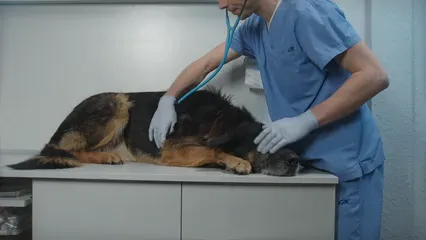
Treatment Options for Mite Infestations
Topical and Oral Medications
Treating mite infestations typically involves a combination of topical and oral medications. Your veterinarian will prescribe specific treatments based on the type of mites affecting your dog. Common topical options include medicated shampoos, creams, and spot-on treatments designed to kill mites on contact.
Oral medications may also be necessary, especially for more severe infestations. These medications can help eliminate mites from within your dog’s system. It’s essential to follow your vet’s treatment plan consistently. This ensures that the infestation is fully eradicated and helps prevent secondary infections from occurring. Skipping doses or stopping treatment early can lead to a resurgence of mites and prolong your dog’s discomfort. Always consult your vet if you notice any new symptoms or if the condition doesn’t improve.
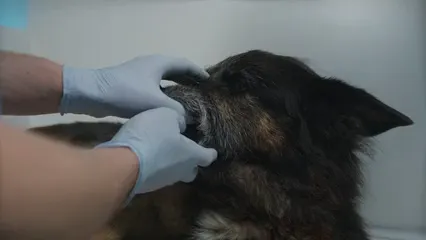
Environmental Cleaning
Cleaning your dog’s living environment is crucial in managing mite infestations. Mites can thrive in bedding, carpets, and furniture. By disinfecting these areas, you reduce the risk of reinfestation. Vacuum regularly and wash your dog’s bedding in hot water. This helps eliminate any lingering mites or eggs.
Consider using mite-repelling sprays or powders on carpets and upholstery, such as a Mite Repelling Spray for Pets. These products can provide an extra layer of protection. Additionally, keep your dog’s grooming tools clean by washing brushes and combs frequently. A tidy environment not only benefits your dog but also contributes to your home’s overall hygiene.

Preventive Measures
Maintaining a mite-free environment for your pet involves regular grooming and cleaning. Brush your dog often to remove loose fur and dander. Bathing your dog with a vet-recommended shampoo can also help keep their skin healthy. This routine helps you spot any early signs of mites.
For those hot summer days, your pup will appreciate a Dog Cooling Mat. It’s a perfect way to keep them comfortable while lounging around, and it can help reduce stress during mite treatments!

Conclusion
Understanding and addressing mites on dogs is vital for their well-being. These tiny pests can lead to discomfort and serious health issues if ignored. By taking proactive measures, you can protect your dog from infestations. Always consult your veterinarian if you suspect your dog has mites. They can provide guidance and treatment, ensuring your furry friend stays healthy and happy.

For those pet owners who love to travel, a Pet Carrier Backpack can be a fantastic investment. It’s perfect for hiking trips or just a day out in the park with your furry friend!
Please let us know what you think about our content by leaving a comment down below!
Thank you for reading till here 🙂
All images from Pexels

